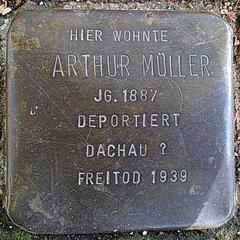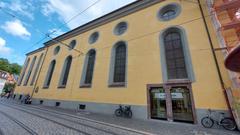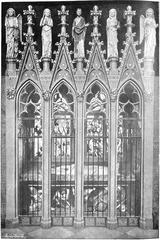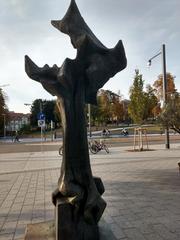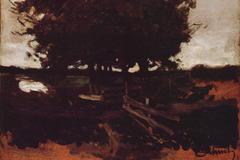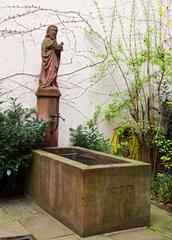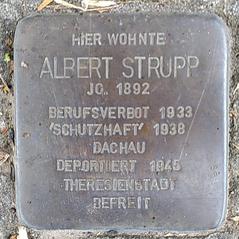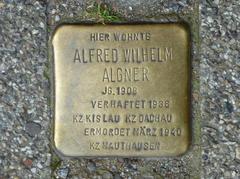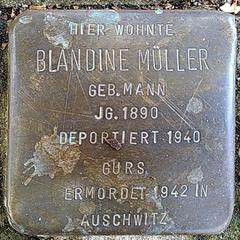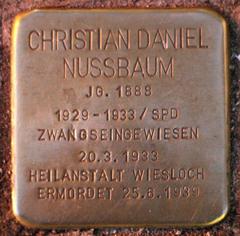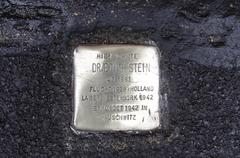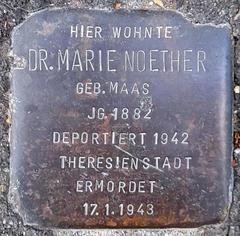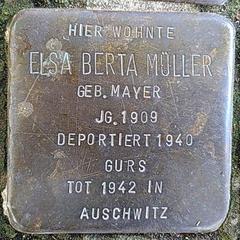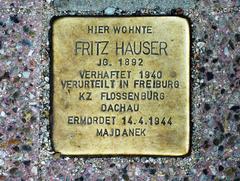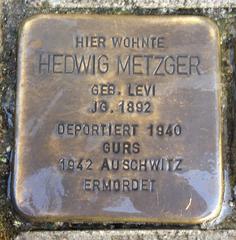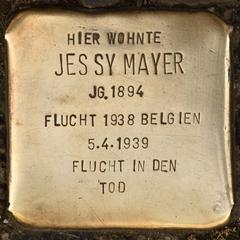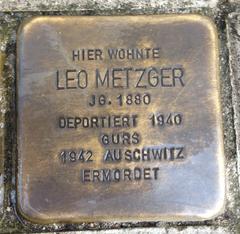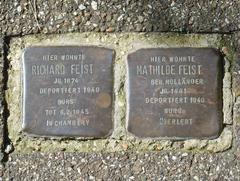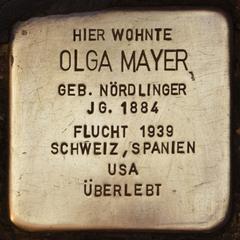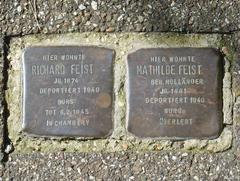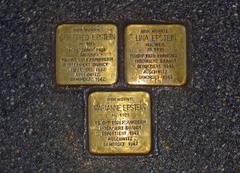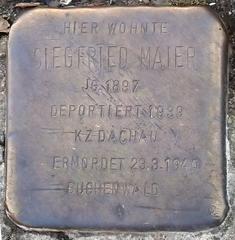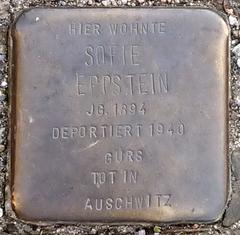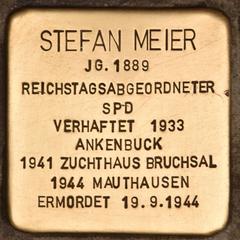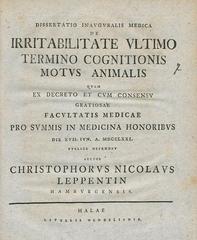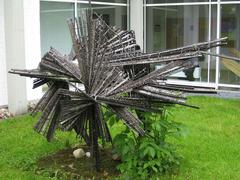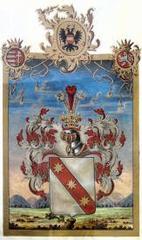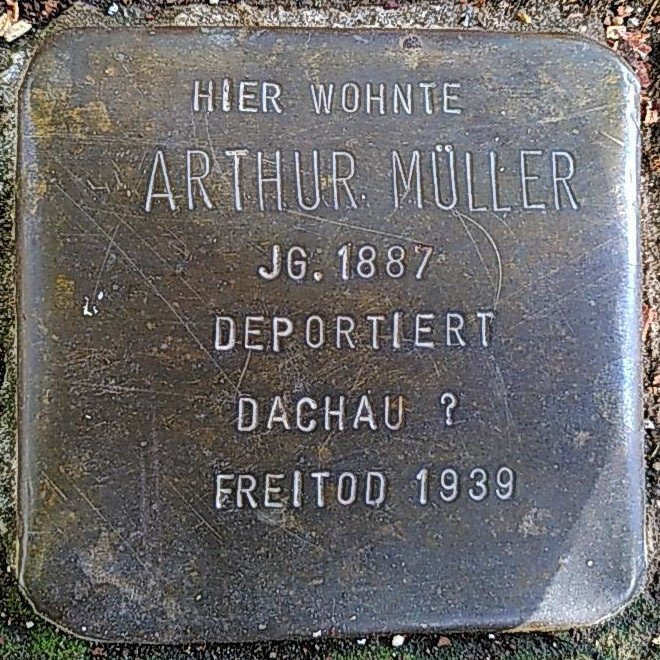
Complete Guide to Visiting the Stolperstein Dedicated to Arthur Müller in Freiburg im Breisgau, Germany
Date: 14/06/2025
Introduction
The Stolperstein dedicated to Arthur Müller in Freiburg im Breisgau is a powerful and intimate memorial within Europe’s largest decentralized remembrance project. Conceived by artist Gunter Demnig in 1992, the Stolpersteine (“stumbling stones”) initiative honors victims of Nazi persecution by embedding small brass plaques at their last freely chosen residences. The stone commemorating Arthur Müller—along with family members Blandine Müller and Elsa Berta Müller—lies at Elsässerstraße 35a, offering both residents and visitors a direct, personal encounter with history.
This detailed guide provides the historical context of the Stolpersteine project, a biography of Arthur Müller, visitor information including hours and accessibility, tips for meaningful engagement, and practical resources for exploring related sites in Freiburg. By engaging with this memorial, you participate in an ongoing act of remembrance and reflection, ensuring that the lessons of the past remain present in our daily lives (pragueviews.com; denkmalprojekt.org; stolpersteine-in-freiburg.de).
Table of Contents
- Origins and Development of Stolpersteine
- Who Was Arthur Müller?
- Symbolism and Cultural Significance
- Location, Visiting Hours, and Accessibility
- Guided Tours and Educational Resources
- Visitor Etiquette and Practical Tips
- Community Involvement and Maintenance
- Controversies and Ethical Considerations
- Frequently Asked Questions (FAQ)
- Nearby Attractions and Further Exploration
- Conclusion and Call to Action
- References and Further Reading
Origins and Development of Stolpersteine
Initiated by Gunter Demnig in 1992, the Stolpersteine project was created to commemorate individuals persecuted and murdered by the Nazi regime. Instead of centralized monuments, the project places hand-engraved brass plaques into sidewalks at victims’ last freely chosen residences. This approach fosters personal engagement and ensures that remembrance is woven into the fabric of everyday life. As of 2025, over 100,000 Stolpersteine have been installed across 27 European countries, making it the world’s largest decentralized Holocaust memorial (pragueviews.com; Germany.info; fabriziomusacchio.com).
The project is rooted in the belief that “a person is only forgotten when his or her name is forgotten.” Each stone, meticulously engraved by hand, restores individuality lost to the anonymity of mass violence and integrates memory into the cityscape (stolpersteine-berlin.de).
Who Was Arthur Müller?
Arthur Müller was born in 1887 and lived with his family at Elsässerstraße 35a in Freiburg im Breisgau. Alongside him, Blandine Müller (née Mann, born 1890) and Elsa Berta Müller (née Mayer, born 1909) are also commemorated by Stolpersteine at the same address. The family’s fate reflects the tragic experience of Freiburg’s Jewish community under the Nazi regime—marked by persecution, forced displacement, and, for many, deportation and murder (denkmalprojekt.org; stolpersteine-in-freiburg.de).
These personal memorials serve as enduring reminders of individuals whose lives and contributions were violently cut short, and help to humanize the broader historical narrative of the Holocaust in Freiburg (stolpersteine-in-freiburg.de).
Symbolism and Cultural Significance
The term “Stolperstein” is metaphorical: while the stones do not trip passersby physically, they are designed to make people “stumble” in thought and reflect on the lives commemorated beneath their feet. Reading a Stolperstein requires a bow of the head—a gesture of respect and remembrance. Placing these memorials at the last freely chosen residences reestablishes a connection between victims and their communities, making the loss personal and tangible (pragueviews.com; Folklife Magazine).
Stolpersteine now honor not only Jewish victims but also Sinti and Roma, people with disabilities, LGBTQ+ individuals, political prisoners, and others persecuted by the Nazis (stolpersteine-berlin.de).
Location, Visiting Hours, and Accessibility
- Address: Elsässerstraße 35a, Freiburg im Breisgau, Germany
- Access: The Stolperstein is embedded in the public sidewalk and accessible 24/7, year-round.
- Fees: There is no admission fee.
- Accessibility: The site is wheelchair accessible. However, Freiburg’s old town features some cobblestone streets, so visitors with mobility concerns should plan accordingly (visit.freiburg.de).
For precise directions, consult the official Stolpersteine Freiburg map or inquire at the Freiburg Tourist Information Office.
Guided Tours and Educational Resources
To deepen your understanding, several local organizations and the Freiburg tourism office offer guided walking tours focusing on Jewish history and the Stolpersteine. These tours provide context, personal stories, and insights into the significance of each stone. Schedules and languages can be checked via the Stolpersteine Freiburg website or local providers.
Digital resources, including interactive maps and mobile apps, support visitors in locating Stolpersteine and accessing biographies and historical information (fabriziomusacchio.com; commons.wikimedia.org).
Visitor Etiquette and Practical Tips
- Pause and Reflect: Take a moment to read the inscription and consider the life commemorated.
- Respect the Site: Avoid standing or sitting directly on the stones; instead, stand beside them to observe and photograph.
- Photography: Discreet, respectful photography is welcome. The reflective brass plaques are particularly photogenic in natural light.
- Remembrance Gestures: Placing small stones, flowers, or candles beside a Stolperstein follows Jewish tradition and is considered respectful.
- Combine Visits: Explore other Jewish heritage sites nearby, such as the Old Synagogue Square or the Jewish Museum Freiburg (juedisches-museum-freiburg.de).
- Weather Preparedness: Freiburg’s climate is mild but variable; check the forecast and bring appropriate gear for rain or sun.
Community Involvement and Maintenance
Community participation is central to the Stolpersteine project. Individuals, families, schools, and organizations sponsor stones and often take part in installation ceremonies. Local volunteers and residents, especially school groups, help maintain the stones by cleaning and polishing them during remembrance days such as January 27 (International Holocaust Remembrance Day) and November 9 (anniversary of Kristallnacht) (stolpersteinecz.cz; stolpersteine-in-freiburg.de).
Controversies and Ethical Considerations
While widely embraced, Stolpersteine have also generated debate. Some critics express discomfort with memorials “underfoot,” arguing that walking over victims’ names may be disrespectful. Supporters, including Demnig, emphasize the intent to honor and remember, noting the symbolic act of bowing to read the stones. In some German cities, such as Munich, Stolpersteine are prohibited on public streets and instead installed on private property (Folklife Magazine).
Freiburg has largely supported the project, but ongoing dialogue continues about the best ways to commemorate all victim groups.
Frequently Asked Questions (FAQ)
Q: Are there any fees or tickets required to visit the Stolperstein for Arthur Müller?
A: No, the memorial is publicly accessible and free of charge.
Q: Can I visit the Stolperstein at any time?
A: Yes, it is accessible 24/7 as it is embedded in a public sidewalk.
Q: Are guided tours available in Freiburg?
A: Yes, several organizations and the tourism office offer tours focusing on Stolpersteine and Jewish history.
Q: Is the site accessible for people with disabilities?
A: The area is generally accessible, though some cobblestone streets may pose minor challenges.
Q: Is photography permitted?
A: Yes, respectful photography is encouraged.
Nearby Attractions and Further Exploration
Pair your visit to Arthur Müller’s Stolperstein with other significant sites in Freiburg:
- Freiburg Minster (Cathedral)
- Old Town Hall (Altes Rathaus)
- Münsterplatz square
- Jewish Museum Freiburg (juedisches-museum-freiburg.de)
- Old Synagogue Square
Interactive maps and brochures are available at the Freiburg Tourist Information Office.
For digital exploration, consult resources and photo galleries on commons.wikimedia.org.
Conclusion and Call to Action
The Stolperstein dedicated to Arthur Müller is more than a historical marker—it is a living invitation to reflect, remember, and honor the individuals whose lives were irreparably changed by hatred and intolerance. By visiting, you connect with a tradition of memory that spans continents and generations.
To further enrich your experience:
- Download the Audiala app for interactive maps and audio guides.
- Participate in guided tours and remembrance events.
- Share your visit on social media using #StolpersteinArthurMüller or #FreiburgRemembers.
- Stay informed about new installations and events via the Stolpersteine Freiburg website and official city channels.
Your respectful engagement ensures that the memory of Arthur Müller and countless others endures as a vital part of Freiburg’s—and Europe’s—shared history.
References and Further Reading
- pragueviews.com
- denkmalprojekt.org
- stolpersteine-in-freiburg.de
- fabriziomusacchio.com
- Germany.info
- visit.freiburg.de
- stolpersteine-berlin.de
- commons.wikimedia.org
- Folklife Magazine
- stolpersteinecz.cz
- juedisches-museum-freiburg.de
